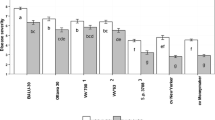Abstract
Pseudomonas syringae pv.pisi, pea bacterial blight agent, is seed-transmitted. Some aspects of its life cycle and its biology were investigated. The colonization of pea plants obtained from naturally infected seeds was studied in natural conditions while high populations of bacteria developed on plants showing no symptoms. Two streptomycin-resistant mutants were used to study the epiphytic life of the pathogen. Populations were monitored in different host-parasite compatibilities. When race 2 or race 6 of the pathogen was surface-inoculated on susceptible cultivars, a decrease of population size was observed during the following one to three days but was followed by an increase to levels 1000 times greater than the initial number detected, without symptoms for most of the plants. When race 2 was surface-inoculated on resistant genotypes or race 6 on non-host plants, bacteria did not multiply but population levels slightly decreased.Pseudomonas syringae pv.pisi shows a resident phase and its development is race-specific. Weeds collected in naturally contaminated pea fields, diseased or not, often harboured the pathogen but with levels smaller than those observed on peas. Pea crop debris and volunteers kept high levels of bacteria for at least eight months after the harvest of a diseased crop. As long as two pea crops are not grown one after the other in the same field, it is unlikely that debris and volunteers will act as an important inoculum source. The development of this pathogen during the growing season is considered as an important parameter to take into account for controlling the disease through seed health testing.
Similar content being viewed by others
References
Crosse JE (1959) Bacterial canker of stone-fruits. IV. Investigation of a method for measuring the inoculum potential of cherry trees. Ann appl Biol 47: 306–317
Crosse JE (1963) Bacterial canker of stone-fruits. V. A comparison of leaf-surface populations ofPseudomonas mors-prunorum in autumn on two cherry varieties. Ann appl Biol 52: 97–104
Ercolani GL, Hagedom DJ, Kelman A and Rand RE (1974) Epiphytic survival ofPseudomonas syringae on hairy vetch in relation to epidemiology of bacterial brown spot of bean in Wisconsin. Phytopathology 64: 1330–1339
Grondeau C, Saunier M, Poutier F and Samson R (1992a) Evaluation of physiological and serological profiles ofPseudomonas syringae pv.pisi for pea blight identification. Plant Pathol 41: 495–505
Grondeau C, Ladonne F, Fourmond A, Poutier F and Samson R (1992b) Attempt to eradicatePseudomonas syringae pv.pisi from pea seeds with heat treatments. Seed Sci Technol 20: 515–525
Hattingh MJ, Roos IMM and Mansvelt EL (1989) Infection and systemic invasion of deciduous fruit trees byPseudomonas syringae in South Africa. Plant Dis 73: 784–789
Hirano SS and Upper CD (1990) Population biology and epidemiology ofPseudomonas syringae. Annu Rev Phytopathol 28: 155–177
Hirano SS and Upper CD (1993) Dynamics, spread, and persistence of a single genotype ofPseudomonas syringae relative to those of its conspecifics on populations of snap bean leaflets. Appl environ Microbiol 59: 1082–1091
Latorre BA and Jones AL (1979)Pseudomonas morsprunorum, the cause of bacterial canker of sour cherry in Michigan, and its epiphytic association withP. syringae. Phytopathology 69: 335–339
Leben C (1965) Epiphytic microorganisms in relation to plant disease. Annu Rev Phytopathol 3: 209–230
Leben C, Schroth MN and Hildebrand DC (1970) Colonization and movementofPseudomonas syringae on healthy bean seedlings. Phytopathology 60: 677–680
Lindemann J, Arny DE and Upper CD (1984) Epiphytic populations ofPseudomonas syringae pv.syringae on snap bean and nonhost plants and the incidence of bacterial brown spot disease in relation to cropping patterns. Phytopathology 74: 1329–1333
Mansvelt EL and Hattingh MJ (1987) Scanning electron microscopy of colonization of pear leaves byPseudomonas syringae pv.syringae. Can J Bot 65: 2517–2522
Mew TM and Kennedy BW (1971) Growth ofPseudomonas glycinea on the surface of soybean leaves. Phytopathology 61: 715–716
Samson R, Maufras JY, Poutier F, Rat B and Gaignard JL (1988) Nouvelles données épidémiologiques sur la graisse bactérienne du pois protéagineux. ANPP, Proceed. ‘Ilé conf. int. sur les maladies des plantes’. 8–10 Nov. 1988: 943–949
Schneider RW and Grogan RG (1977) Bacterial speck of tomato: sources of inoculum and establishment of a resident population. Phytopathology 67: 388–394
Stadt SJ and Saettler AW (1981) Effect of host genotype on multiplication ofPseudomonas phaseolicola. Phytopathology 71: 1307–1310
Skoric V (1927) Bacterial blight of pea: overwintering, dissemination and pathological histology. Phytopathology 17: 611–627
Taylor JD, Bevan JR, Crute IR and Reader SL (1989) Genetic relationship between races ofPseudomonas syringae pv.pisi and cultivars ofPisum sativum. Plant Pathol 38: 364–375
Young JM, Dye DW and Close RC (1969) Bacterial blight of peas. N Z J Agric 119: 144–147
Author information
Authors and Affiliations
Rights and permissions
About this article
Cite this article
Grondeau, C., Mabiala, A., Ait-Oumeziane, R. et al. Epiphytic life is the main characteristic of the life cycle ofPseudomonas syringae pv.pisi, pea bacterial blight agent. Eur J Plant Pathol 102, 353–363 (1996). https://doi.org/10.1007/BF01878130
Accepted:
Issue Date:
DOI: https://doi.org/10.1007/BF01878130




